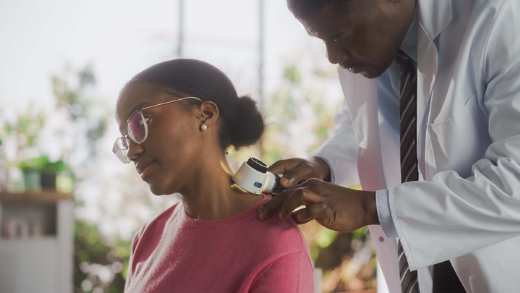Melanoma skin cancer and health insurance
Supporting you through skin cancer

What is melanoma?
Melanoma is a type of skin cancer which develops in the cells that produce melanin, the pigment that gives skin its colour. It’s the most serious type of skin cancer and one of the most common cancers in the UK. The main cause of melanoma is thought to be exposure to ultraviolet (UV) radiation from the sun, but other factors such as family history might increase your risk as well. If caught early, most melanomas can be treated successfully.
What’s the relationship between moles and melanoma?
Moles themselves don’t usually pose a health risk, but in rare cases changes in existing moles or the growth of new moles can be signs of melanoma.
Moles are small, dark spots on the skin that can be either flat or raised. They range in colour from light pink to dark brown or black. Normal (benign) moles are usually round and symmetrical (the same on both sides) and tend to be a single colour. Cancerous (malignant) moles are more often asymmetrical (different on each side) and tend to be a mix of two or more colours.
You should get a mole checked if you notice any changes in the way it looks or feels. Remember, though, that melanoma doesn’t always start in existing moles: in fact, 70-80% of melanoma develops on other areas of your skin. It’s much more common in areas that get lots of sun, like your face and neck, but it can appear anywhere, including under your hair and between your toes.
What are the warning signs of melanoma?
Knowing the warning signs of melanoma is important for finding and treating the condition early. Common warning signs include:
- changes in the size, shape, or colour of existing moles
- the appearance of new moles
- itching, pain, or bleeding from existing moles
It can be helpful to remember the ABCD of moles, a checklist explaining some of signs of melanoma.
Who is at risk of developing melanoma?
Anyone can get melanoma, but your risk is higher if you have:
- more exposure to ultraviolet (UV) rays from the sun or tanning beds
- a family history of melanoma (link)
- fair skin
- lots of moles or freckles
Whatever your individual risk, you should check your skin regularly and see your doctor if you notice any changes.
How can you help prevent melanoma?
You can’t always prevent melanoma, but you can lower your risk by taking the following steps:
- finding shade on hot days
- wearing sunscreen year round
- wearing a broadbrimmed hat
- wearing clothes that cover your arms and legs
- avoiding tanning beds and sunlamps
How is melanoma diagnosed?
Diagnosis often starts with a physical exam, where your doctor will look for any suspicious moles or changes in skin colour or texture. If your doctor thinks you might have melanoma, they’ll usually recommend a sample be removed for testing (a biopsy)— it’s not possible to tell whether tissue is cancerous from a physical exam alone. Imaging tests like X-rays and CT scans can also be used to find out if the cancer has spread from where it started.
We cover a range of tests for diagnosing melanoma. And if you’re diagnosed, we cover tests such as molecular profiling that help doctors decide which treatment will be most effective.
How is melanoma treated?
How melanoma is treated depends on its stage and severity. Surgery is often used to remove the tumour and a small area of skin around it. If the melanoma is discovered early, surgery may be all that’s needed. If discovered later, the cancer is more likely to have grown or spread to other areas, meaning treatment can require radiation or chemotherapy, immunotherapy, or targeted therapy. Radiation therapy and chemotherapy are used to kill cancer cells or shrink tumours. Immunotherapy helps your body’s immune system fight off cancer cells, while targeted therapy targets specific molecules on cancer cells.
We offer extensive cancer cover, including cover for surgery, chemotherapy, radiotherapy, and targeted therapy, as well as comprehensive aftercare and monitoring.
How can I use my cover to pay for melanoma tests and treatment?
The first step in using your cover for melanoma tests and treatment is to get a referral from your GP, or through our digital GP app. Then you can make a claim through MyAviva, over the phone, or online.
Once we’ve confirmed your claim meets the terms of your policy, we’ll pay any eligible medical bills directly. Just be sure to tell us if you need more tests or treatment, or if your hospital or specialist changes.
You can learn all about our health insurance and get a quote from our health insurance page.
We've got cancer covered
Our cancer pledge means you're supported throughout your cancer journey.



